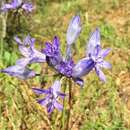en
names in breadcrumbs


M. E. Barkworth (1975, 1977) studied variation within Triteleia grandiflora in relation to ploidy level. Polyploid plants are larger, flower later, and have more effective vegetative reproduction by cormlets and contractile roots than their diploid progenitors.
Plants of Triteleia grandiflora from the area west of the Cascade Range and extending into the Columbia River valley and the Klamath Lake region that have been distinguished as var. howellii differ from others of the species only in the shape of the filaments. L. Abrams and R. S. Ferris (1923–1960, vol. 1) used relative perianth length as a key character, but this is not consistent (R. F. Hoover 1941), and several specimens from the part of the Columbia River valley where both filament morphologies occur appear to represent intergrades (R. F. Hoover 1955). Thus it seems inadvisable to recognize infraspecific taxa. Plants assignable to var. howellii have not been found in California or southwestern Oregon in recent decades, and may be extirpated there.
Triteleia bicolor is merely a color form having a perianth with a blue tube and white lobe.
Triteleia grandiflora is a species of flowering plant known by the common names largeflower triteleia,[2] largeflower tripletlily, and wild hyacinth.
Triteleia grandiflora is a perennial herb growing from a corm. It produces two or three basal leaves up to 70 centimetres (28 in) long by 1 cm wide. The inflorescence arises on a smooth, erect stem up to 75 cm (30 in) tall and bears an umbel-like cluster of many blue to white flowers. Each flower is a funnel-shaped bloom borne on a pedicel up to 4 or 5 cm long. The flower may be up to 3.5 cm long including the tubular throat and six tepals each just over 1 cm long. The inner set of three tepals are somewhat ruffled and broader than the outer tepals. The flower corolla may be deep blue to almost white with a darker blue mid-vein. There are six stamens with purple or yellow anthers. The prominent tubular flower throat distinguishes T. grandiflora from Triteleia hyacinthina, whose range overlaps T. grandiflora.
Triteleia grandiflora is native to western North America from British Columbia to extreme northern California, eastward into Idaho, Montana and northern Utah, with disjunct populations occurring in Wyoming and Colorado.[3][4] Its habitat includes grassland, sagebrush, woodlands, and forests.
The corm provides food for various wild rodents and livestock, and Native Americans and settlers found them edible as well.[3]
Triteleia grandiflora is a species of flowering plant known by the common names largeflower triteleia, largeflower tripletlily, and wild hyacinth.